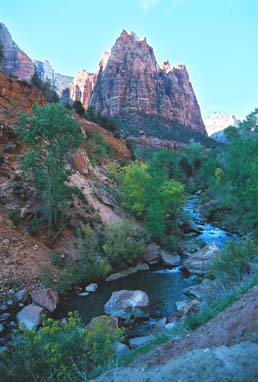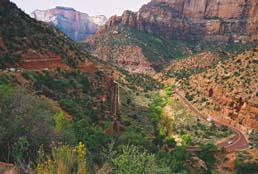Day 12: Zion National Park, Utah

Can you see the rock-climbers about two-thirds of the way up the wall? Of course not. The cliffs are too large and the pixels too few. These cliffs are 250-350 stories tall–two or three Sears Towers could be stacked atop one another and still not reach the canyon rim.
After vacating our cabin and driving thru the lower canyon to nearby Springdale for breakfast, we return to the park to choose a campsite. Then it’s off to the museum for a bit of geological and human history and a beautiful introductory film of Zion National Park.
But to truly appreciate the grandeur of Zion one must actually see it, and the National Park Service shuttle busses make it easy, even with 2.5 million annual visitors. If riding a shuttle bus sounds like a hassle, consider instead the alternative of sitting immobilized in the fume-laden, bumper-to-bumper traffic snarls that were common before the new bus system. Not the most enjoyable way to experience the great outdoors.
Instead, as the bus driver points out noteworthy sites of interest, we ride in air-conditioned comfort and enjoy the views. When something sounds intriguing we simply hop off at the next stop and go hiking or snap some photos or dabble our toes in the river before catching another bus, another of which comes along every six minutes.
 The spectacular Zion Canyon was carved by the North Fork of the Virgin River, which, over millions of years, has carried away several thousand feet of rock that once lay above the highest layers visible today. The river is still excavating today, eroding the shale, undermining the overlaying sandstone and causing it to collapse, widening the canyon. Occasional landslides and great house-sized chunks of sandstone pried from the walls by the repeatedly freezing-and-thawing water continue to widen the canyon and form rubble heaps at the base of the walls. Darkness falls quickly here in the canyon. The valley is so deep and narrow that the riverbanks receive only about four hours of direct sunlight each day, before the sun vacates that narrow swath of sky overhead and disappears behind the canyon wall. We ride the bus to the visitor center, then stroll back along the Virgin River to camp for a late dinner.
The spectacular Zion Canyon was carved by the North Fork of the Virgin River, which, over millions of years, has carried away several thousand feet of rock that once lay above the highest layers visible today. The river is still excavating today, eroding the shale, undermining the overlaying sandstone and causing it to collapse, widening the canyon. Occasional landslides and great house-sized chunks of sandstone pried from the walls by the repeatedly freezing-and-thawing water continue to widen the canyon and form rubble heaps at the base of the walls. Darkness falls quickly here in the canyon. The valley is so deep and narrow that the riverbanks receive only about four hours of direct sunlight each day, before the sun vacates that narrow swath of sky overhead and disappears behind the canyon wall. We ride the bus to the visitor center, then stroll back along the Virgin River to camp for a late dinner.








